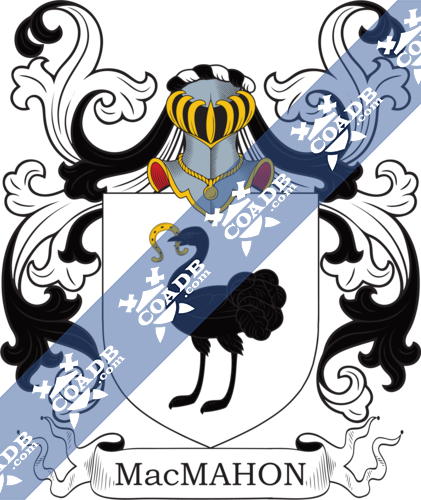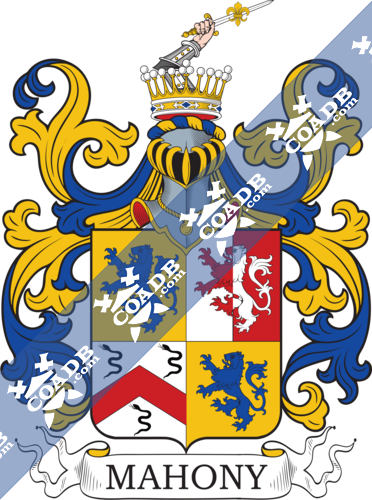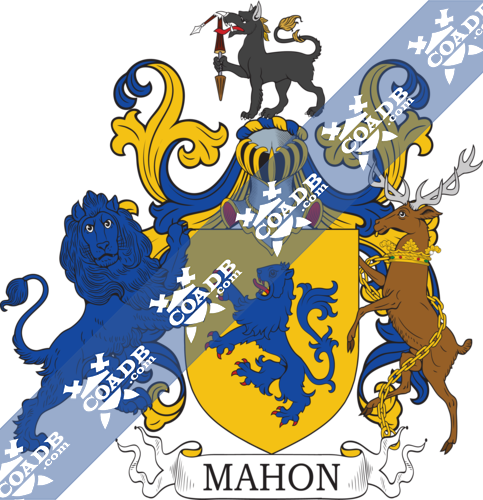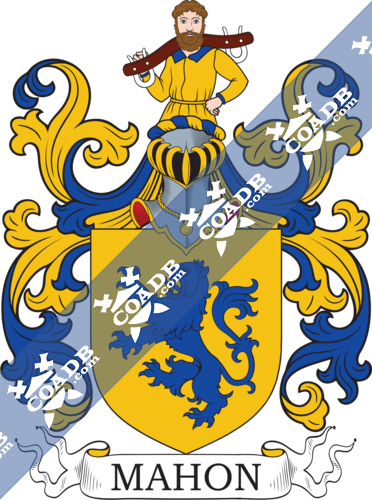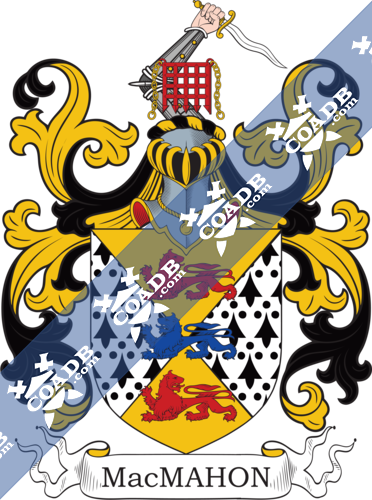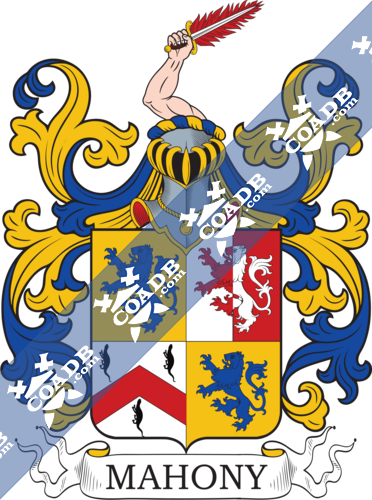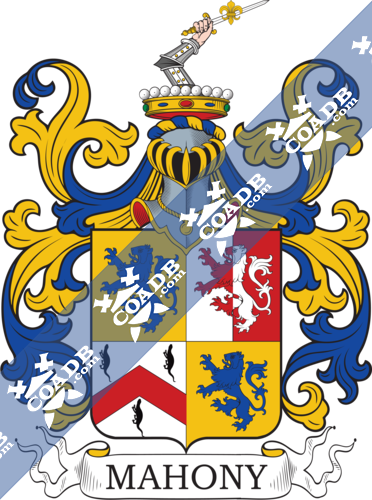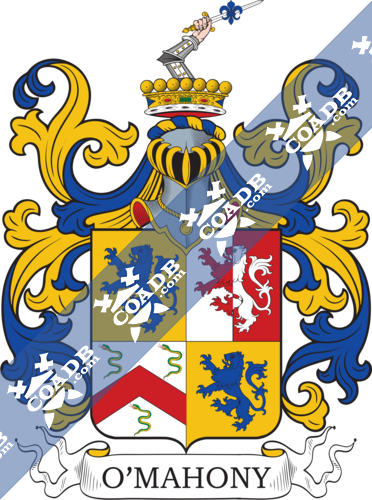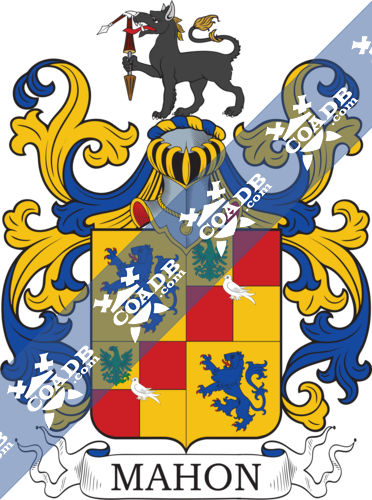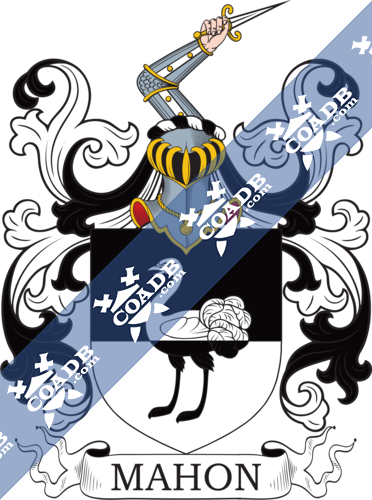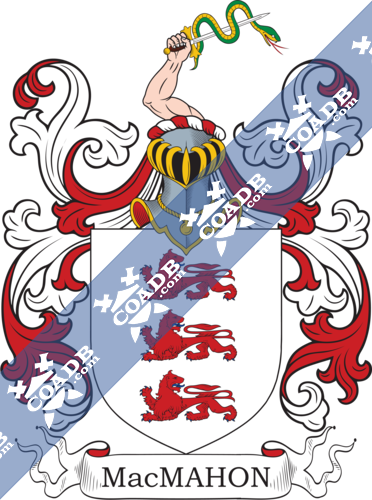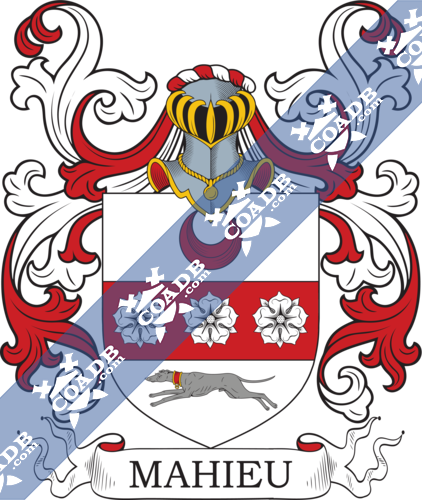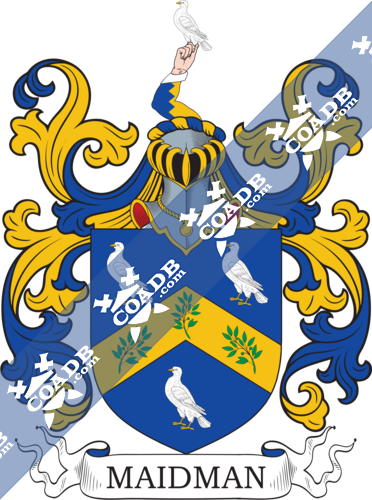Mahon Family Crest, Coat of Arms and Name History
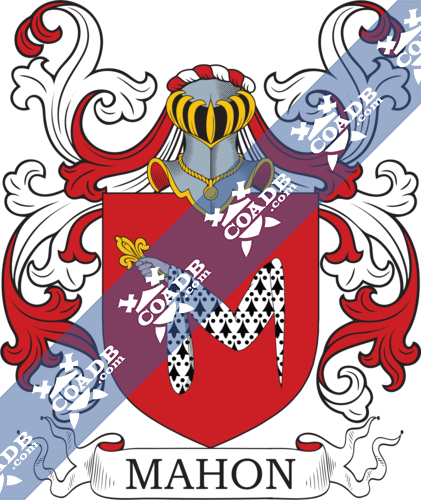
Mahon Coat of Arms Gallery
Don’t know which Coat of Arms is yours?
We can do a genealogical research. Find out the exact history of your family!
Learn MoreSurname Name Meaning, Origin, and Etymology
Mahon is a distinguished Irish surname that’s early recorded history can be traced back to the 900s AD, though variations of the name have existed as early as the Middle ages. It is an Anglicized form of the Ancient Irish masculine name “Mathghamhna”—which later became Mac Mathuna—both names mean “bear” in Irish Gaelic. Mathghamhain was the name of the brother of the Irish king Brian Boru (941 AD – 1014 AD).
Traditionally, Irish family names are taken from the heads of tribes or from famed warriors and can be pre-fixed by “O,” which denotes grandson or male descendant of, or “Mac,” which means “son of.” “Mac Mathghamhain” would mean “son of Mathghamhain.” There are two different clans that currently bear this name in Ireland. The first belong to County Clare and are descended from Mahon, son of Murtagh Mor O’Brien, former King of Ireland (deceased 1119 AD). The second clan of “M(a)cMahon” were lords of Oriel—an ancient territory consisting of the Counties Armagh, Monaghan and parts of South Down, Louth and Fermanagh—in the 13th Century.
Spelling Variations
Common spelling variants and names with similar etymological origins include the following: Mahan, Mohan, MacMahon, McMahon, MacMann, MacMahan, MacMohan and more. The first recorded spelling of the name is “MacMahon” (dated 1170), during the reign of Rory O’Connor, the last native High King of Ireland. Surnames became necessary when governments introduced personal taxation (known as the “Poll Tax” in England). Over time, surnames in every country have continued to “develop,” which explains why there are so many variants of the original spelling.
Popularity & Geographic Distribution
Mahon, or MacMahon, ranks 133rd in popularity in Ireland and and 618th in Northern Ireland. It holds third place on the list of most popular County Monaghan surnames. It is the 16,780th most common surname in the world, with approximately 31,288 people bearing it. Mahon is a fairly common surname in the United States. When the 2000 Census was taken, there were approximately 9,327 individuals with the last name “Mahon,” ranking it number 3,504 for all surnames in the country. It is heavily skewed towards the Caucasian population in the United States (91.12%). The name has been most prevalent in the Northeastern United States, especially in New Jersey. Historically, the surname Mahon pairs most often with the first names John (5.6117%), James (4.4415%) and Mary (4.2819%).
Early Bearers of the Surname
Many namebearers of Mahon or MacMahon were leaders of the Catholic Confederacy of the mid-seventeenth century. At this time, Hugh MacMahon—the last MacMahon chief—and Heber MacMahon, the Bishop of Clogher, were executed. In the following century, three MacMahon Bishops of Clogher went on to become pirates, including Hugh MacMahon (died 1737) and his nephews Bernard (died 1747) and Ross Rod (died 1748). Bernard and many of the other Bishops later went on to become Archbishops of Armagh.
History, Genealogy, and Ancestry
The MacMahon family is descended from Milesins, King of Spain, through the lineage of his son Heber. The family is divided into three branches—the McMahons of Clare in the province of Munster, the MacMahons of County Fermanagh in the province of Ulster and the MacMahons of Monaghan also in the province of Ulster. The McMahons of Clare were lords of Corca Baisgin (or Corcu Baiscind, early Érainn people from County Clare) who owned the greater part of the baronies of Moyarta and Clonderlaw. They were the descendants of Murtagh Mor O’Brien (or Murkertach Mor), who was the King of Ireland (deceased 1119) of the royal house of Brian Boru. The MacMahons of Monaghan were at a time chieftains of the present Counties of Fermanagh, Monaghan and Louth, as well as in the Kings of Oirghialla and Fidia, in the present County of Down. These MacMahons were brave and warlike, they defended their possessions against the English in the time of Elizabeth. The MacMahons of Fermanagh were also chiefs in their county, where they had possession of large amounts of property. This branch of the family can be traced back to Colla Da Crioch, Eocaidh Duiblen and Cabri Lifficar to Heremon, the son of Milesins.
Heber MacMahon became the famous Bishop of Clogher in June 1643 and played a prominent part in the Irish Catholic Confederation in Kilkenny. He worked closely with Owen Roe O’Neill (the commander of the Ulster army of Irish Confederates) throughout the 1640s. After O’Neill’s mysterious death in 1649, the Earl of Ormonde appointed Bishop MacMahon the leader of the Ulster army—which comprised of 5,000 foot soldiers and 600 cavalry. As general of the Ulster Army, he fought Oliver Cromwell (the famed English military and political leader and later Lord Protector of the Commonwealth of England, Scotland, and Ireland) at the Battle of Scarrifholis, near Letterkenny, in 1650. Although he escaped, he was captured, hanged and beheaded by Sir Charles Coote in Enniskillen.
Early American and New World Settlers
Irish families began leaving their homeland for North America en masse in the late 18th century. These families were fairly well-off, but were looking forward to owning and working on a sizable tract of their own land. The Great Potato Famine that followed in the 1840s sparked a huge emigration of destitute Irish people—they would not get land grants in North America because at this point the East Coast had reached its saturation point and free land was scarce. They instead were looking to escape the starvation, disease and hopelessness that had befallen Ireland.
Unfortunately, these Irish immigrants did not receive a warm welcome in the United States and Canada, though their arrival was critical to the rapid development enjoyed by the two nations, as they helped to populate western lands and provided the cheap labor that was required for the industrialization that was occurring. Many settlers in the United States and Canada during this time bore the name Mahon, including settlers in New York, Pennsylvania, South Carolina, Nova Scotia and New Brunswick.
The name is still numerous in many parts of Ireland as well as in the United States and the British Colonies.
Mottoes and Crests
The Mahon family motto is Sic nos sic sacra tuemur, which translates to “Thus we guard our sacred rights.” It was originally a war cry or slogan. Given the Mahon’s history of battle and defending their land against English imperialism, this is a fitting motto. In the Mahon’s heraldry, the arms are argent, an ostrich sable, holding a fer de cheval in the beak. The family crest features a naked arm embowed, holding a sword, the point pierced through a fleur-de-lis sable. In layman’s terms, this means that the crest is a silvery color that features a human arm bent like the letter “S” atop it, holding a sword that is piercing a black flower. The crest also features a black ostrich (a common bird found on heraldry) that is holding a golden horseshoe in its beak.
Notables
There are many notable people throughout history who have the surname Mahon or its varietals. A few outstanding ones include:
- The aforementioned Heber MacMahon (1600 – 1650), Irish bishop and general.
- Bernard MacMahon (1680 – 1747), an Irish bishop.
- Edmond Patrice, Compte de MacMahon (1808 – 1893), the Marshal of France and President of the Third Republic for six years.
- Hugh Mahon (1857 – 1931), Irish-born, Australian politician, member of the Australian Parliament from 1901 – 1913.
- Sir Henry McMahon (1862 – 1949), British soldier and High Commissioner in Egypt.
- John Joseph “Sadie” McMahon (1867 – 1954), Major League Baseball pitcher who was active from 1889 – 1897 and played for the Philadelphia Athletics, Baltimore Orioles and Brooklyn Bridegrooms from
- Aline MacMahon (1899 – 1991), American actress. Academy Award winner for her performance in Dragon Seed (1941).
- Bryan MacMahon (1909 – 1998), Irish playwright, novelist and short story writer.
- Elizabeth B. Mahon (1919 – 2001), American female outfielder who played from 1944 – 1954 in the All-American Girls Professional Baseball League.
- Jackson Barrett “Barry” Mahon (1921 – 1999), American film director, cinematographer, producer and manager of actor Errol Flynn.
- Ed McMahon (1923 – 2009). American entertainer known for his work on The Tonight Show Starring Johnny Carson.
- Ivor McMahon (1924 – 1972), English violinist.
- Ciarán Mac Mathúna (1925–2009), Irish broadcaster.
- Tony MacMahon (born 1939), Irish button accordion player and radio and television broadcaster.
- Thomas A. McMahon (1943 – 1999), American professor of applied mechanics and biology at Harvard, accredited novelist.
- Kevin McMahon (born 1953), industrial rock musician of the bands Lucky Pierre and Prick.
- Michael McMahon (born 1957), former New York City Councilman and current United States Congressman from the 13th district of New York State.
- Jennifer McMahon (born 1968), American novelist.
- Julian McMahon (born 1968), actor, son of former Australian Prime Minister William McMahon.
- Andrew McMahon (born 1982), of the rock bands Jack’s Mannequin and Something Corporate.
- Éabha McMahon (born 1992), Irish alto singer and member of the ensemble Celtic Woman.
- The McMahon wrestling family including Vince McMahon, Jr. (born 1948), the chairman of the board, CEO and majority shareholder of the WWE, his wife Linda McMahon (born 1948), the former CEO of WWE and current Administrator of the Small Business Administration, and their son Shane McMahon (born 1970), the former Executive President of WWE Global Media.
Blazons & Genealogy Notes
1) (Ireland). Or, a lion ramp. az. Crest—A demi husbandman holding over the dexter shoulder an ox-yoke ppr.
2) (Baron Hartland, extinct 1845). Or, a lion ramp. az. armed and langued gu. Crest—An heraldic tiger statant, holding in the dexter paw a broken tilting spear all ppr. Supporters—Dexter, a lion guard, az.; sinister, a atag ppr. ducally gorged and chained or. Motto—Periculum fortitudine evasi.
3) (Pakenham-Mahon; exemplified to Henry Sandford Pakenham, Esq., who m. Grace, dau. and heiress of Dsms Mahon, Esq., of Strokestown, co. Roscommon, upon his assuming, by royal licence, 1847, the additional surname and arms of Mahon). Quarterly, 1st and 4th, or, a lion ramp. az. armed and langued gu., for Mahon; 2nd and 3rd, quarterly, or and gu., in the 1st quarter an eagle displ. vert, a martlet for diff., for Pakenham. Crest—An heraldic tiger pass. holding in the dexter paw a broken tilting spear ppr. Motto—Periculum fortitudine evasi.
4) (Castlegar, co. Galway, bart.). Per fesse sa. and ar. an ostrich counterchanged. Crest—A dexter arm in armour embowed ppr. garnished or, holding in the hand a dagger also ppr. pommel and hilt gold. Motto—Moniti meliora sequamur.
5) Gu. out of a maunch erm. a hand ppr. holding a fleur-de-lis or.
6) (Cavetown, co. Roscommon, confirmed, 1884, to Liept.-Col. Maurice Hartland Mahon, son of Rev. Arthur Mahon, of Cavetown, and grandson of Robert Mahon, Esq., Cavetown, and to the other descendants of his grandfather. This last named Robert was son of Ven. Arthur Mahon, Archdeacon of Elphin, whose father, Very Rev. Peter Mahon, Dean of Elphin, was 4th son of Nicholas Mahon, Esq., of Ballinemly, same co. and brother of John Mahon, Esq.. of Strokestown, the grandfather of Maurice, 1st Lord Hartland). Or, a lion ramp. az. langued gu. a martlet sa. for diff. Crest—An heraldic tiger pass, holding in the dexter paw a broken tilting spear all ppr. and charged on the shoulder with a martlet sa. for diff. Motto—Buaidh go bragh.
“7) (of the same Sept O’Brien, Earls of Thomond and Inchiquin, anciently Kings of Thomond; Turlough Mac Mahon, of Clonderlaw, co. Clare, Reg. Ulster’s Office as chiefof his Sept in 1472). (Coagy and Tuagh, co. Clare; descended from Mac Mahon, of Clonderlaw; allowed by Mac Cullogh, Ulster, 1764). (Leadmore, co. Clare; descended from Mac Mahon, of Coagy; allowed by Mac Cullogh, Ulster, 1764). (Cornelius MacMahon, Count of the Holy Roman Empire, descended from Mac Mahon, of Clonderlaw, through MacMahon, of Coagy, co. Clare, Tuagh, and Ballykielty, co. Limerick; allowed by Bryan, Deputy Ulster, 1770). (Marie Edme Patrick Maurice Mac Mahon, Duke of Magenta, Marshal of France, President of the French Republic; allowed by Hawkins, Ulster, 1750, to the Marshal’s ancestor, John Baptist Mac Mahon, Count of Eguilly, son of Patrick Mac Mahon, Esq., of Torrodile, co. Limerick, descended from Donogh Mac Mahon, Lord of Finish and Reynana, son of Turlogh Mac Mahon, Lord of Clonderlaw, and chief of his Sept, 1472. The head of the Mac Mahons, of France, is the Marquis de Mac Mahon, of Sully, near
Autun). (Portugal; allowed by Hawkins, Ulster, 1749, to Maurice Mac Mahon, Major in the service of the King of Portugal, descended from Donogh MacMahon, younger son of Terence Mac Mahon, of Clonderlaw, chief of his Sept 1472). Ar. three lions pass, reguard. in pale gu. armed and langued az. Crest—A dexter arm in armour embowed ppr. garnished or, holding in the hand a sword both ppr. pommel and hilt gold. Motto—Sic nos sic sacra tuemur.”
8) (Clenagh, Ballylean, &c., co. Clare, of the ancient Sept of the Mac Mahons, of Clare; Jane McMahon, sister and heir of Rev. Donat McMahon, of Clenagh, to. William Coppinger, Esq., of Barryscourt, co. Cork, and d. 1833, leaving, with two sons, who d. s. p., an elder dau., Elizabeth Coppinger, who in., 1806, John O’Connell, Esq., of Grenagh, co. Kerry, and had, with other issue, an elder son, Morgan John O’Connell, M.P., co. Kerry, who to., 1865, Mary Anne, only dau. of Charles Bianconi, Esq., of Longfield, co. Tipperary, and d. 1875, leaving John Charles Coppinger O’Connell, Esq., 6. 1871, the present representative of this line). Same Arms. Crest—A naked arm embowed holding a sword the blade entwined with a serpent all ppr. Motto—Sic nos sic sacra tuemur.
9) (co. Monaghan; impalement Fun. Ent. Ulster’s Office, 1623, Capt. Нugh Reilly, of Lecanon, co. Cavan, whose wife was Katherine, dau. of Sir Brian McMahon, Knt.). Ar. an ostrich sa. holding in the beak a horseshoe or.
10) (Dublin, bart.; granted by Betham. Ulster, to Right Hon. William MacMahon. Master of the Rolls, Ireland, created a bart. 1815). (London, bart.; Right Hon. John McMahon, elder brother of Sir William Mac Mahon, Bart., Master of the Rolls, was created a bart., with special remainder to hi brother, Thomas McMahon, 1817). Per saltire or and erm. a lion pass. az. betw. two lions pass. reguard. gu. all in pale. Crest: Behind a portcullis gu. chained or, an armed arm embowed ppr. the hand grasping a sword wavy ppr. hilted and pommelled of the second. Motto—Sic nos sic sacra tuemur.
11) (Lords of Oirghialla or Oriel, the present co. of Monaghan, an ancient Sept in Ulster of the same race as McGuire, Lord of Fermanagh, descended from Colla da Chrioch; they had their chief seat at Dartree. The Annals of the Four Masters record, under the year 1273, that Eochaidh MacMahon, Lord of Oirghialla, was slain with many others, by the people of Tyrone. Art MacMahon, eldest son and heir of Sir Brian MacMahon, Knt., chief of his name, died according to his Fun. Ent. Ulster’s Office, A.D. 1634). Ar. an ostrich sa. holding in the beak a horseshoe or. Crest—A naked arm embowed holding a sword all ppr. the point pierced through a fleur-de-lis sa. Mottoes—So dorn dona dhubhfuiltibh; and Manus haec inimica tyrannis.
12) (Hollymount, co. Carlow). Quarterly, 1st and 4th, or, a lion ramp. gu.; 2nd, gu. a sinister arm in armour embowed, holding in the hand a sword bendwise, hilted or; 3rd, az. a sinister hand and arm couped at the elbow, holding a sword erect wavy with a snake entwined thereon all ppr. Crest—A demi griffin segreant ar.
13) (Dunloe Castle, co. Kerry; allowed by Fortescue, Ulster, 1792, as the arms of Daniel Mahony, Esq., of Dunloe, descended from O’Mahony, of Castle O’Mahony, co. Cork). Quarterly, 1st and 4th, or, a lion ramp. az.; 2nd, per pale ar. and gu. a lion ramp. counterchanged; 3rd, ar. a chev. gu. betw. three lizards in pale sa. Crest—A naked arm embowed, the hand grasping a sword flammant all ppr. Another Crest—An arm in armour embowed, holding a sword all ppr. run through a fleur-de-lis or. Motto—Lasair romhuin a buadh.
14) (allowed by Fortescue, Ulster, 1792, to William Mahony, Knight of the Order of Maria Theresa, an officer in the Austrian Service, second son of John Mahony, Esq., of Dunloe Castle). Same Arms and Motto. Crest—Out of a foreign coronet or, with nine silver balls on the rim, an arm in armour embowed, holding a sword all ppr. run through a fleur-de-lis gold.
15) (exemplified by Betham, Ulster, to John Hickson, a minor, second son of John Hickson, Esq., of Dingle, co. Kerry, on his assuming, by royal licence, 1827, the surname of Mahony only, in memory of his maternal uncle, Richard Mahony, Esq., of Dromore, co. Kerry). Quarterly, 1st and 4th, or, a lion ramp. az.; 2nd, per pale ar. and gu. a lion ramp. counterchanged; 3rd. ar. a chev. gu. betw. three snakes wavy in pale sa. Crest—Out of the coronet of a count of France, a dexter arm armed, embowed ppr. the hand bare, grasping a sword ppr. hilt and pommel or, run through a fleur-de-lis of the last. Motto—Lasair romhuin a buadh.
16) (a Sept possessing the territory of Hy Eathach, or Ivaugh, co. Cork, deriving their name from Mathghamhna, Chief of the Sept, 1014). (allowed by Hawkins, Ulster, 1712, to John Mahony, Captain of a regiment in the service of the Emperor of Germany, son of Jeremiah Mahony, Colonel in the army of James II., descended from the O’Mahonys, co. Cork). Quarterly, 1st and 4th, or, a lion ramp. az.; 2nd, per pale ar. and gu. a lion ramp. counterchanged; 3rd, ar. a chev. gu. betw. three snakes torqued ppr. Crest—Out of a viscount’s coronet or, an arm in armour embowed, holding a sword ppr. pommel and hilt or, pierced through a fleur-de-lis az.

